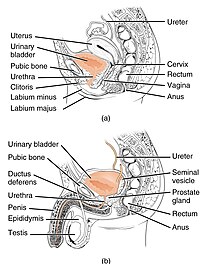
Photo from wikipedia
Abstract Urinary incontinence is a common and debilitating problem in patients undergoing radical prostatectomy. Current methods developed to treat urinary incontinence include conservative treatments, such as lifestyle education, pelvic muscle… Click to show full abstract
Abstract Urinary incontinence is a common and debilitating problem in patients undergoing radical prostatectomy. Current methods developed to treat urinary incontinence include conservative treatments, such as lifestyle education, pelvic muscle floor training, pharmacotherapy, and surgical treatments, such as bulking agents use, artificial urinary sphincter implants, retrourethral transobturator slings, and adjustable male sling system. Pelvic floor muscle exercise is the most common management to improve the strength of striated muscles of the pelvic floor to try to recover the sphincter weakness. Antimuscarinic drugs, phosphodiesterase inhibitors, duloxetine, and a-adrenergic drugs have been proposed as medical treatments for urinary incontinence after radical prostatectomy. Development of new surgical techniques, new surgical tools and materials, such as male slings, has provided an improvement of outcomes after UI surgery. Such improvement is still ongoing, and the uptake of new devices might lead to even better outcomes after UI surgery.
Journal Title: Therapeutics and Clinical Risk Management
Year Published: 2023
Link to full text (if available)
Share on Social Media: Sign Up to like & get
recommendations!